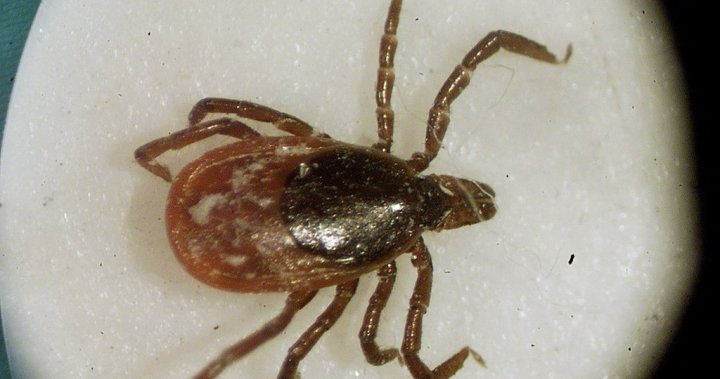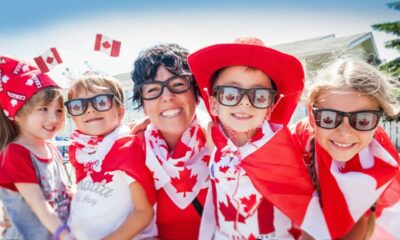Climate change driving rise in tick-borne illnesses such as Lyme disease

A warming climate is driving a rise in Lyme disease and the introduction of lesser-known tick-borne diseases, public health specialists say.
“Climate change in Canada is happening at a much more accelerated rate than we see in parts of the rest of the world,” said Heather Coatsworth, chief of field studies at the National Microbiology Laboratory in Winnipeg.
“Ticks, which are eight-legged organisms, but general bugs, all require a certain amount of heat and humidity to complete their life cycle,” she said.

Ontario, Quebec and Nova Scotia continue to be the hot spots for blacklegged ticks, which can carry bacteria, parasites and viruses that cause disease in humans — but the changing climate is allowing the tick population to grow in other parts of the country, including Manitoba, Saskatchewan, Alberta and British Columbia, Coatsworth said.
Janet Sperling, a scientist who specializes in bugs and the president of the Canadian Lyme Disease Foundation, said that means increased awareness of tick-borne illnesses is needed not only among the public, but among primary-care providers and infectious disease specialists.
“A lot of doctors have been told — this was their training — ‘you can’t get Lyme disease in Alberta; if you don’t have a travel history don’t worry about it,’” said Sperling, who lives in Edmonton.
“There’s no doubt that it has changed and the education hasn’t caught up with some of the doctors,” she said.
The rise in tick-borne disease doesn’t mean you should stay inside, experts agree. But you can protect yourself. Here’s what to know about the illnesses and how to safely enjoy the summer weather.
How common is Lyme disease?
Lyme disease has been on the rise in Canada and the United States for several years. When provincial public health units started monitoring it in 2009, they reported 144 cases across the country. The preliminary case count for 2024 is 5,239, according to the Public Health Agency of Canada.
The real number is likely higher because many people may have had very general symptoms and never got a diagnosis, Coatsworth said.
“There’s estimates that if things keep going the way they are and climate change keeps going the way things go, that in 25 years we’d have about half a million cases of Lyme disease here in Canada,” she said.
What are the symptoms of Lyme disease?
Lyme disease can feel like many other illnesses and may bring on fever, chills, fatigue, headache, swollen lymph nodes and/or muscle and joint aches.
One telltale sign of Lyme disease is a rash that looks like a bull’s eye, a target or that is circular or oval-shaped.
But Coatsworth cautions that about 30 per cent of people who are infected never get a rash, so a Lyme disease diagnosis shouldn’t be ruled out if people have other symptoms.

What are some other tick-borne diseases?

Get weekly health news
Receive the latest medical news and health information delivered to you every Sunday.
In the last couple of years, some provinces have started monitoring three other diseases spread by blacklegged ticks: anaplasmosis, babesiosis and Powassan virus.
Of those, anaplasmosis — although still rare — seems to be growing the fastest, said Coatsworth: “It’s kind of the new kid on the block.”
When public health officials first started monitoring it around 2012, there were about 10 to 50 cases per year in Canada.
There were more than 700 cases of anaplasmosis reported last year, Coatsworth said.
“It’s really picking up speed within the population.”
The symptoms of anaplasmosis can be similar to Lyme disease, without a rash. They can also include cough, diarrhea, abdominal pain and vomiting, according to the Public Health Agency of Canada.
Babesiosis can also cause similar symptoms to Lyme disease without a rash, but it often causes anemia as well, Coatsworth said.
Powassan virus can cause fever, chills, headache, vomiting and general weakness but it often progresses to serious neurological symptoms, such as encephalitis (brain swelling) and meningitis.
Can these diseases be treated?
Lyme disease and anaplasmosis are both caused by bacteria and can be treated with antibiotics, usually starting with doxycycline, said Coatsworth.
Babesiosis is caused by a parasite and is similar to malaria, she said. It can be treated with anti-parasitic medications.
There is no treatment for Powassan virus. Patients are treated with supportive care, which can include intravenous fluids, medications to reduce brain swelling and respiratory assistance.

What kind of ticks carry these dieases?
Two types of blacklegged ticks carry these diseases: Ixodes scapularis, also called a deer tick, is found in several parts of Canada, especially Ontario, Quebec and Nova Scotia. In parts of British Columbia, the dominant tick is Ixodes pacificus, also known as the western blacklegged tick.
Ticks feed on the blood of deer, mice, rabbits and other mammals, as well as birds and reptiles. Birds can carry the ticks long distances, so they can be transported to different parts of Canada. The ticks get infected if the host animal is infected, and they in turn transmit the disease to humans when they bite them and latch on.
What do the ticks look like?
“A lot of people are very surprised when I show them a blacklegged tick. They can’t believe how small they are,” said Dr. Curtis Russell, a vector-borne disease specialist at Public Health Ontario.
An adult tick that isn’t full of blood is about the size of a sesame seed. A younger tick is about the size of a poppyseed.
Where are the ticks found?
Ticks are found in wooded and grassy areas, according to the Public Health Agency of Canada.
That includes forests, parks and hiking trails, but ticks can also live in more populated areas, Coatsworth said.
“(It’s) a lot about the animals that exist in those environments. So a lot of those are peri-urban spaces … kind of those in-between spaces that now have become just maybe your local neighbourhood park where there’s a lot more squirrels. Small rodents and white-tailed deer, especially, have really contributed to sustaining the populations of ticks.”
How do I prevent tick bites?
Preventing tick bites is similar to repelling mosquitoes, said Dr. Mayank Singal, a public health physician with the BC Centre for Disease Control.
Wearing long sleeves, long pants and using bug spray are all important measures. Choosing light-coloured clothing is best because it’s easier to spot a tick when it lands.
Singal also encourages “trying to not come in contact with foliage and bushes, because that’s typically how they will latch on.”
Russell said that means when hiking, stay in the middle of the trail.
After outdoor activities, do a full-body tick check, including parts of the body that weren’t exposed. Russell suggested taking a bath or a shower.
“You can check all your areas where the ticks might have been and if they haven’t bit you yet … they can maybe wash off,” Russell said.
“They usually crawl around … before they bite and they usually tend to bite your hairline, your armpits, the back of your legs, your groin area.”
Russell also recommends washing your clothes and putting them in the dryer, where the high heat will kill ticks.

If I find a tick, should I remove it?
Yes. Do it with tweezers as soon as possible, experts agree.
A tick will embed its mouth in the skin as with the legs sticking out and it’s important to remove the whole tick.
“You want to grab it as close to the skin edge as possible, squeeze the tweezers … and grab the tick and then pull it straight up,” said Singal.
“We don’t want to twist, we don’t want to go left and right. Just pull it straight up so that we get all of it out as much as possible.”
It generally takes about 24 hours for the tick to transmit Lyme disease, anaplasmosis or babesiosis while it’s latched on.
Powassan virus can be transmitted as quickly as 15 minutes after attachment, but very few ticks currently carry the virus, according to the Public Health Agency of Canada.

Then what?
People can take a photo of the tick and submit it to etick.ca, along with information about where you were when you think it bit you. The service, run by several universities and public health agencies, will tell you what kind of tick it is and how much tick-borne disease risk there is in the area.
If you had a tick on you and begin to develop any symptoms, see your health-care provider and let them know you were possibly exposed to tick-borne illness, Russell said.
This report by The Canadian Press was first published June 28, 2025.
Canadian Press health coverage receives support through a partnership with the Canadian Medical Association. CP is solely responsible for this content.


The Supreme Court of Canada has declined to hear an appeal of a lower-court ruling that upheld a First Nation’s ownership of a stretch of land at a popular Ontario beach after a lengthy dispute.
Canada’s top court has dismissed the appeal request from landowners and the province after a stretch of land along Sauble Beach was returned to Saugeen First Nation in 2023.

Get breaking National news
For news impacting Canada and around the world, sign up for breaking news alerts delivered directly to you when they happen.
This dismissal comes nearly two months after members of Saugeen First Nation changed the iconic “Welcome to Sauble Beach” sign that greeted beach visitors.
The temporary “Welcome to Saugeen Beach” sign was erected to reflect the First Nation’s ownership of the land, with the town’s mayor expressing disappointment that he wasn’t alerted of the change.
The Ontario Court of Appeal upheld last December the decision that 2.2 kilometres of the coastline in South Bruce Peninsula was incorrectly surveyed 170 years ago.
The portion of the land is valuable fishing ground for the First Nation community and was surrendered in 1854 in an agreement with the Crown to give up portions of Bruce Peninsula.
© 2025 The Canadian Press

The majority of post-secondary students in Ontario are stressed about their finances heading into the school year, a new survey found.
The survey from TD Bank, which collected data from post-secondary students across the country, found that 92 per cent of all respondents in Ontario are stressed about their finances.
“The survey was clear that our students are experiencing a lot of stress, which is a bit unique from previous generations because of the multitude of factors that are just hypersensitive at this point, with higher unemployment, higher cost of living, higher tuition,” says Joe Moghaizel, vice-president of everyday advice journey at TD.
The survey found that while 78 per cent of Ontario parents believe their child has experienced financial stress in the past three months, that figure was well below the actual number of 92 per cent.
“What’s interesting is the amount of pressure and stress that they’re currently facing and feeling, and the disconnect between what their parents believe they’re experiencing,” Moghaizel says. “Parents were not aware of the amount of stress that the students are feeling.”
Moghaizel pointed to a number of things leading to this financial pressure, including the high cost of living and high rate of unemployment among young people in a difficult job market, leading to many students to have what he called a volatile income.

Get breaking National news
For news impacting Canada and around the world, sign up for breaking news alerts delivered directly to you when they happen.
The survey also found that Ontario had the highest percentage of students stressed about tuition costs at 35 per cent, compared with an average of 26 per cent in other provinces.
The government of Canada estimates it will take almost 10 years for the average student to pay off their student loans and the total student loan debt in Canada surpassed $23.5 billion in 2022.
“You go back to over two decades ago, when I was in school, the financial pressures that students deal with now are significantly higher because tuition is a lot more expensive and the cost of living is more expensive, and inflation has really taken a bite at students,” Moghaizel says.
Another key takeaway from the survey was that 36 per cent of all respondents found that social spending stressed them out the most.
Moghaizel says the social pressure speaks to the online environment that students find themselves in today, where everything they do is shared online.
“They all feel the pressure to spend and keep up, which, again, it’s not too dissimilar from other age groups and we’re keeping up with the Joneses and just keeping up with the spending habit of your circle creates a bit of pressure,” he says.
Moghaizel says this can leave post-secondary students feeling ill-equipped to manage their finances better.
Despite the concern, Moghaizel hopes this information is not discouraging to students and is an opportunity to start establishing good financial habits early in life.
He said that with societal pressures, it’s good for students to understand their needs versus their wants, and focus on prioritizing the necessities. Moghaizel says that through tracking their spending, students can see where all of their money is going.
“We want to make sure that we’re equipping students with the right understanding of financial knowledge for the products and services,” Moghaizel says.
© 2025 Global News, a division of Corus Entertainment Inc.

A Canadian man has pleaded guilty to illegally photographing classified U.S. defence facilities at the Space Force military base in Cape Canaveral, Fla.
Xiao Guang Pan, 71, of Brampton, Ont., pleaded guilty to three counts of unlawful photographing of military installations without authorization on three separate days in early January.
A U.S. District Court in Florida judge put Pan on probation for 12 months and immediately ordered him deported to Canada by U.S. Immigration and Citizenship Enforcement (ICE) officers under the U.S. Immigration and Nationality Act, citing his violations of American espionage laws.
Pan did not immediately respond to a request for comment.
A U.S. Department of Justice official was unsure about where Pan is in the ICE deportation process.
Pan’s guilty plea and deportation come as anxiety grows among U.S. lawmakers and ordinary Americans about hundreds of unidentified drones flying over sensitive American military bases amid concerns about foreign surveillance and spying.
A copy of Pan’s plea agreement reveals a stark contrast between what Pan said he was doing in Florida in January, when he was stopped by police, versus what U.S. federal agents actually found on his drone, phone and storage devices after seizing them.
On an artist biography page published by the Brampton Arts Organization, Pan stated he was born in China in 1953, immigrated to Canada in 2001 and has lived in Brampton since 2003.
Pan worked as a Best Buy Canada technician for 18 years until retirement in 2022, the biography adds.
Pan entered U.S. via Detroit
Pan entered the U.S. on a tourist visa at the Ambassador’s Bridge in Detroit, Mich., on or about Nov. 2, 2024. The court documents don’t suggest what Pan was doing or where Pan travelled in November and December.
The retiree was charged by summons on Feb. 11 after the National Aeronautics and Space Administration (NASA) detected drone activity near the Space Force Base and called in law enforcement on Jan. 7.
Brevard County Sheriffs responded. They saw Pan operating a DJI Mavic Pro 3 unmanned drone quadcopter from a parking lot in Port Canaveral and learned he’d been in the area for three days.
The local officers then tipped federal law enforcement agencies.
Federal agents caught the Brampton resident using his powerful unmanned drone and a separate camera with telephoto lenses to photograph and video classified military facilities and equipment near the Space Force base on Jan. 5, 6 and 7, without the base commander’s prior authorization as required under U.S. law.

Get breaking National news
For news impacting Canada and around the world, sign up for breaking news alerts delivered directly to you when they happen.
According to a statement of facts found in the plea agreement, which Pan signed and initialled on every page, U.S. federal agents interviewed him twice – no dates were given – and asked the Canadian what he was doing with the drone.
They also warned him: lying to federal agents is a federal crime in the U.S.
“Pan told the agents that he had flown his drone to take pictures of the beauty of nature, the sunrise, and the cruise ship port. He stated that he had not seen any launch pads and that he did not know that he was near a military installation,” the plea deal states.
Pan voluntarily submitted his devices to U.S. agents for a forensic data extraction.
That’s when the investigators found more than sunrises, nature and cruise ship videos.
The data showed Pan had flown his drone nine times and taken 1,919 photographs and videos during his three-day Florida visit, the plea deal states.
Of those 1,919 photos and videos, 243 photographs and 13 videos showed specific images of Space Force base military infrastructure and launch facilities, including fuel and munitions storage facilities, security checkpoints, and a Navy submarine platform, according to the plea agreement.
On Jan. 6, his second day of flying the drone quadcopter, Pan took nine videos and 166 photographs of Space Force installations.
This time, he launched his drone from a location several miles closer to the base; his photographs and videos captured the same military infrastructure as on Jan. 5, but in higher quality and from different angles, according to the plea agreement.
Pan also captured images and videos of mission control infrastructure and fuel and munitions facilities, including a photograph of a Space Launch Complex and payload processing facilities operated by two defence contractors.
On the third day of his drone flying, and before he was encountered by law enforcement, Pan recorded two more videos and took 56 photos.
Day 3 images included security checkpoints
His Day 3 images and videos showed roads, power distribution infrastructure, security checkpoints, mission control infrastructure, national security space launch infrastructure, fuel and munitions storage, and naval infrastructure, the plea agreement states.
After police stopped Pan on Jan. 7, federal agents interviewed him twice.
During those interviews, Pan was warned that lying to agents is a federal crime. He did so anyway, the plea deal suggests.
In addition to telling agents he flew his drone to record nature, sunrises, and cruise ships and didn’t know he was near a military base, Pan said his drone sends alerts and warnings to his handset and he received no alerts or warnings, the plea deal adds.
Investigators recovered flight log data from Pan’s quadcopter. It showed that on all three days he flew, the drone logged several alerts and sent operator messages about altitude and FAA airspace violations.
On Pan’s cell phone, agents also found several screenshots he created, including several Google Maps satellite overviews of Cape Canaveral. One screenshot taken Jan. 7 while Pan was at his drone launch location, prominently displayed the words “Cape Canaveral Space Force Station.”
Pan surrendered his $5,000 quadcopter
Pan was charged in February after a multi-agency probe led by the U.S. Federal Bureau of Investigation, U.S. Homeland Security, and the U.S. Air Force Office of Special Investigations.
Pan surrendered his $5,000 quadcopter, control equipment and storage devices that housed his videos and photos to the U.S. authorities.
He is also banned from returning to the U.S. without prior consent from the Secretary of the Homeland Security department.

-

 Uncategorized3 months ago
Uncategorized3 months agoShop Proud, Eat Proud, Be Proud — Ottawa Canada Day Market This June 28th
-

 3 months ago
3 months agoCanada’s world junior trial saw juries tossed, intense testimony. Here’s a recap
-

 2 months ago
2 months agoRing of Fire road to bring prosperity to First Nation, problems for caribou: report
-

 2 months ago
2 months agoMeasles circulating in northeastern B.C. community, health officials warn
-

 3 months ago
3 months agoAnishinabek Nation chief says he briefed Ontario police on protests against Bill 5
-

 2 months ago
2 months agoFormer major leaguer, Jays doctor Ron Taylor dies
-

 2 months ago
2 months agoJagmeet Singh apologizes for attending Kendrick Lamar concert after Drake calls him out
-

 2 months ago
2 months agoDreaming of a lakeside cottage but can’t afford it? Co-ownership could open that door









